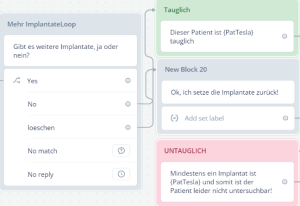Design and Evaluation of a Tool for Determining MRI Safety of Patients with Voiceflow in Comparison to Using the MagResource Database
Aim and Research Question(s)
This research tackles a technology which is already widely spread in the everyday life of many: voice assistance. To see, whether it can provide an equal or better alternative in the medical field, specifically talking about MRI safety of patients with various implants, a Voiceflow skill has been created to answer, whether voice assistance can provide faster results, correct results and a more user-friendly experience compared to conventional internet and database research.
Background
MRI safety plays a big part in the daily lives of radiographers and determining whether patients can be scanned in certain environments can be a time consuming task. As not every implant can safely be scanned without thorough previous research, information about implant type, localization and material has to be provided beforehand [1]. Important surgery documents often lack information, therefore an alternative was created, which aims to be an easily accessible and reliable method of achieving this task.
Methods
The participants (n=21) consists exclusively of employees of the "Institut Frühwald & Partner Diagnosezentrum". A constructed database of 30 existing implants of various MRI Safety levels, some can be seen in figure 1, which are distributed over 10 fictional patients will be used.
 Figure 1: Example of Flow for Patient Safety Classification.
For both of the compared methods (Magresource research and Voiceflow) the UEQ (User Experience Questionnaire), a stopwatch for measuring the time and a previously set up database for deciding correctness of the results will be used respectively with several weeks between data acquisition of each method to ensure, enough time to correctly process and interpret resulting data.
Figure 1: Example of Flow for Patient Safety Classification.
For both of the compared methods (Magresource research and Voiceflow) the UEQ (User Experience Questionnaire), a stopwatch for measuring the time and a previously set up database for deciding correctness of the results will be used respectively with several weeks between data acquisition of each method to ensure, enough time to correctly process and interpret resulting data.
Results and Discussion
Voice assistance shows to be advantageous in two of the three evaluated categories:
- it produced 100% correct results, compared to 98,1% correct results by MagResource
- it achieved higher scores regarding "Stimulation" and "Novelty" using the UEQ benchmark
MagResource Research was advantageous in one category:
- the time to finish the tasks was shorter by measuring both the average time taken per patient and the sum of all the patients times per participant
Conclusion
While voice assistance showed advantages in two of the three categories, participants commented on the sometimes lacking reliability of the voice recognition. At the same time the interest in the technology proved to be high and through further development, as using A.I. (Artificial Intelligence) to improve intent recognition or streamlining the dialog to save time during the tasks, voice recognition can be of tremendous assistance in the topic of MRI safety research.
References
[1] Panych, L. P., & Madore, B. (2017). The physics of MRI safety. Journal of Magnetic Resonance Imaging, 47(1), 28–43. https://doi.org/10.1002/jmri.25761
